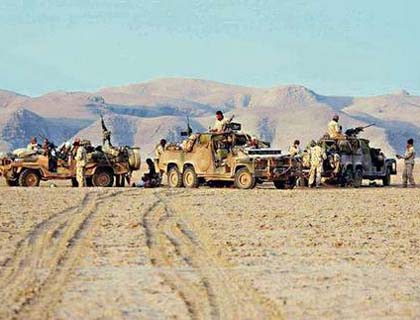KABUL - A Secret US Army report has undermined a glowing Australian account of the role Afghan forces played in repelling an unprecedented Taliban attack near Australia's main base in Afghanistan.
The 166-page report obtained by The Sunday Age, raises fresh doubts about the capacity of Afghan forces to take over when Australian and other foreign troops pull out.
The federal government insists the Afghans are on track to take charge of security by 2014, so Australians can leave.
The Australian Defense Force praised what it said was the prompt, professional and coordinated Afghan response to the Taliban attack in Tarin Kowt on July 28 last year.
But the US report paints a picture of confusion, with Afghan forces failing to respond to a key part of the Taliban assault - an attempt to kill a militia leader who is a close ally of Australian Special Forces.
Afghan forces were either absent or stood by and watched as US troops attacked Taliban fighters who had blasted their way into the government broadcasting station adjoining the compound of militia leader Matiullah Khan.
Adding to the confusion was the fact US troops could not distinguish between official Afghan forces and the militia. While Afghan forces repelled a related Taliban assault on the nearby governor's office, US troops were on their own at the broadcasting station.
Standard procedure was for Afghan forces to take the lead in clearing a building where the Taliban were holed up.
In their absence, US troops stormed the building, with disastrous consequences. Two Taliban fighters detonated suicide vests, burying seven soldiers, including the battalion commander, Lieutenant-Colonel David Oeschger, who was seriously wounded.
In what the report says was the ''stress and urgency of the moment'', a US soldier then shot dead Afghan journalist Ahmad Omaid Khpalwak, in the mistaken belief he was a suicide bomber. Afghan forces only moved into the building once the Taliban and the journalist were killed, and wounded Americans were dug out of the rubble.
The US report also suggests the Australian response to the attacks was more extensive than the ADF revealed at the time.
Initially classified as secret, the report was heavily censored before being released to The Sunday Age under the US Freedom of Information Act. Even so, it contains detail rarely, if ever, released by Australian agencies.
The report details the findings of a US army inquiry into the killing of Khpalwak, a journalist for a local news agency and the BBC who had worked for Australian outlets, including The Sunday Age.
When US troops rushed to the broadcasting station, they found a confused scene. They were not sure if Afghan troops at the site were militia or government forces, as they wore the same uniforms. The militia operated ''in a grey area'' and were not formally recognized by NATO forces, the report says.
As for the Afghan National Police, ''they did not have a significant organized presence'' at the scene. Whether militia, army or police, the Afghan forces ''did not appear to be actively responding to the situation in an organized manner''.
A US platoon commander said when he arrived at the scene Afghan forces ''were on the west side of the compound or standing on the roofs watching the fight''.
Another US soldier said police ''only showed up'' after two suicide explosions. He said: ''I was disappointed the ANP did not show up earlier; I expected them to clear the building.''
With limited or no co-ordination at the scene, there were wider problems of linking-up between Afghan and foreign troops, according to a US company commander.
US officers could not communicate with Afghan counterparts, who rely on mobile phones, as the phone system was overloaded. ''Therefore there was no real co-ordination with the ANP,'' which failed to block routes or set up traffic check points around the scene.
The company commander said a key lesson from the attack was: ''Continually reiterate ANP [go in] first, even if they need a nudge from US forces to act.''
Afghan forces performed better elsewhere, taking the lead in defending the governor's compound, where they killed the Taliban attackers, throwing one of the bodies off the roof.
The US report reveals Australian troops were present during the fighting at the governor's compound.
Two days after the attack, the ADF denied Australian soldiers were ''involved in the immediate response'' to the attacks. But one US soldier said that when he arrived at the compound, he found Australian soldiers outside and a ''firefight taking place inside''.
Another said Australian and US soldiers at the scene ''worked out a plan … to infiltrate the complex in order to rescue'' Afghan officials trapped inside.
But with Afghan forces dispatching the Taliban, the rescue plan was not needed. A day after the attacks, the ADF issued a statement saying Afghan forces responded ''quickly and professionally to the insurgent action''.
The ADF said the wounds suffered by US soldiers - one of whom was shot in the neck and shoulder and others who were evacuated for treatment in Germany after being buried under rubble - were ''relatively minor''.
It said the Afghan army ''effectively coordinated'' the response to the attacks. (Agencies)

